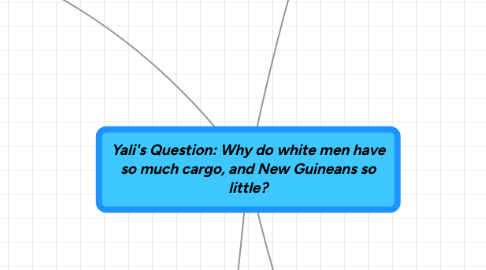
1. Agriculture
1.1. Crops
1.1.1. Wheat and barley in the Middle East
1.1.2. Able to sustain much larger populations
1.1.3. Led to the development of large civilizations
1.1.4. Food surplus allows for specialists
1.1.4.1. Specialists able to develop technology
1.1.4.2. Steel
1.1.4.3. Guns
1.1.5. Stalks of cereal grains can be used to feed livestock
1.2. Livestock
1.2.1. Steady source of meat
1.2.2. Draft animals eased farming
1.2.2.1. Most powerful machines before the Industrial Revolution
1.2.2.2. Made for more productive farming
1.2.3. Living in close proximity with animals allows epidemic viruses native to those animals to evolve strains infectious to humans
1.2.3.1. Smallpox
1.2.3.2. Europeans resistant to these diseases, but spread them to other people who succumbed easily
1.2.3.3. Germs
1.2.4. Animal husbandry 9000 years old
1.2.5. Waste can be used to fertilize crops
1.3. Geography
1.3.1. Eurasia's East-West distribution allows for the easy spread of crops and livestock
1.3.1.1. Areas with similar latitude often have similar climates and identical day lengths
1.3.1.2. Where crops and people are easily spread, so are ideas and technology
1.3.2. Most desirable crops native to Eurasia
1.3.2.1. High in protein
1.3.2.2. Easily cultivated
1.3.3. Almost all large domesticable livestock native to Eurasia
1.3.3.1. Pigs
1.3.3.2. Goats
1.3.3.3. Sheep
1.3.3.4. Arabian Camels
1.3.3.5. Bactrian Camels
1.3.3.6. Horses
1.3.3.6.1. Many military uses
1.3.3.7. Calves
1.3.3.8. Donkeys
1.3.3.9. Water Buffalo
1.3.3.10. Reindeer
1.3.3.11. Yaks
1.3.3.12. Bali Cattle
1.3.3.13. Only llamas native elsewhere
1.3.4. Wheat, barley and most important livestock native to one particular area of the Middle East: the Fertile Crescent
2. Humanity in Pre-History
2.1. Hunter-gatherers
2.2. Some New Guineans have the same lifestyle
2.3. Small, nomadic groups
2.3.1. Mostly relied on gathering plants, supplimented by hunting animals
2.3.2. Would go wherever the food was
2.3.3. Not easy to sustain a population
2.4. First known village around 11,500 years old
2.4.1. First granary
2.4.2. Permanent settlement
2.4.3. Dwellings treated like homes
2.4.4. Unable to be sustained by hunting and gathering
2.5. Civilization grew up in the Middle East; the Fertile Crescent
2.5.1. Later forced to move into Europe due to environmental factors
2.5.2. Ironically not well-suited to intensive agriculture
3. The Spanish Conquest of the Inca Empire
3.1. November 1532
3.2. Pizarro and his men capture Atahuallpa and massacre his troops
3.2.1. Atahuallpa learns Spanish in captivity
3.2.2. Is promised his freedom in return for gold and silver
3.2.3. 20 tons of gold and silver given to Pizarro
3.2.4. Killed when no longer useful
3.3. Horses
3.3.1. Men on horseback terrifying
3.3.1.1. Thought to be gods
3.3.1.2. Llamas never ridden
3.3.1.3. Spanish horseriding particularly unnerving
3.3.2. Higher ground - clear tactical advantage
3.4. Technological Superiority
3.4.1. Swords
3.4.1.1. Very difficult to perfect
3.4.1.1.1. Specialized labor required
3.4.1.1.2. Steel made from iron and carbon
3.4.1.1.3. Many variations
3.4.1.2. Pizarro's men had rapiers - useful for horseback combat
3.4.2. Guns
3.4.2.1. Not very accurate
3.4.2.2. Absolutely terrifying
3.4.2.2.1. Sound like thunder cracking
3.4.2.2.2. Again evocative of godhood
3.5. Tactical mistakes by Atahuallpa
3.5.1. No weapons
3.5.2. Arrogance
3.6. The written word
3.6.1. Allowed for the transmission of knowledge beyond storytelling
3.6.2. Pizarro had likely read works about Cortez' conquest of the Mayan people
3.6.3. Atahuallpa had never seen a book
3.6.3.1. Disregard of the Bible a grievous insult to the Spanish
3.6.4. Incas never developed own writing system
3.6.4.1. Mayans had invented writing
3.6.4.2. North-South axis of the Americas not conducive to spread of people, ideas
3.7. Smallpox
3.7.1. A single man infected with smallpox caused an epidemic in S. America
3.7.2. Evolved from a virus in livestock
3.7.3. Close proximity to livestock both created the virus and gave Europeans some resistance to it
4. Africa
4.1. Never colonized quite like North and South America and Australia
4.2. Southern tip of Africa - same latitude as Europe
4.2.1. Crops and livestock imported with ease
4.3. Dutch voortrekkers pushed North after conquering Khoisan people with ease
4.4. Zulu kingdom sneak attacks voortrekkers
4.5. The Battle of Blood River
4.5.1. Guns used to maximum effect
4.5.2. 3500 Zulus killed with just 3 injured voortrekkers
4.5.3. Revenge for sneak attack
4.6. After crossing the Tropic of Capricorn, livestock and crops start dying
4.6.1. European crops not suited to tropical climate
4.6.2. Only 2 seasons
4.6.3. Tropical Africa much harder to colonize
4.6.4. Superior tech used to subjugate eventually
4.7. Malaria
4.7.1. Infected the colonists who lived in close proximity to mosquito breeding grounds
4.7.2. African tribes lived in small groups in high, dry areas to limit infection and spreading
4.8. Africa Today
4.8.1. Tropical Africa poorest region in the world
4.8.2. Average lifespan 35 years
4.8.3. Malaria number one killer of children
4.8.3.1. Lost productivity
4.8.3.2. Many Africans live in crowded cities
4.8.3.3. Believed to be main cause of African poverty
4.8.3.4. Concentrated effort needed to eliminate malaria
